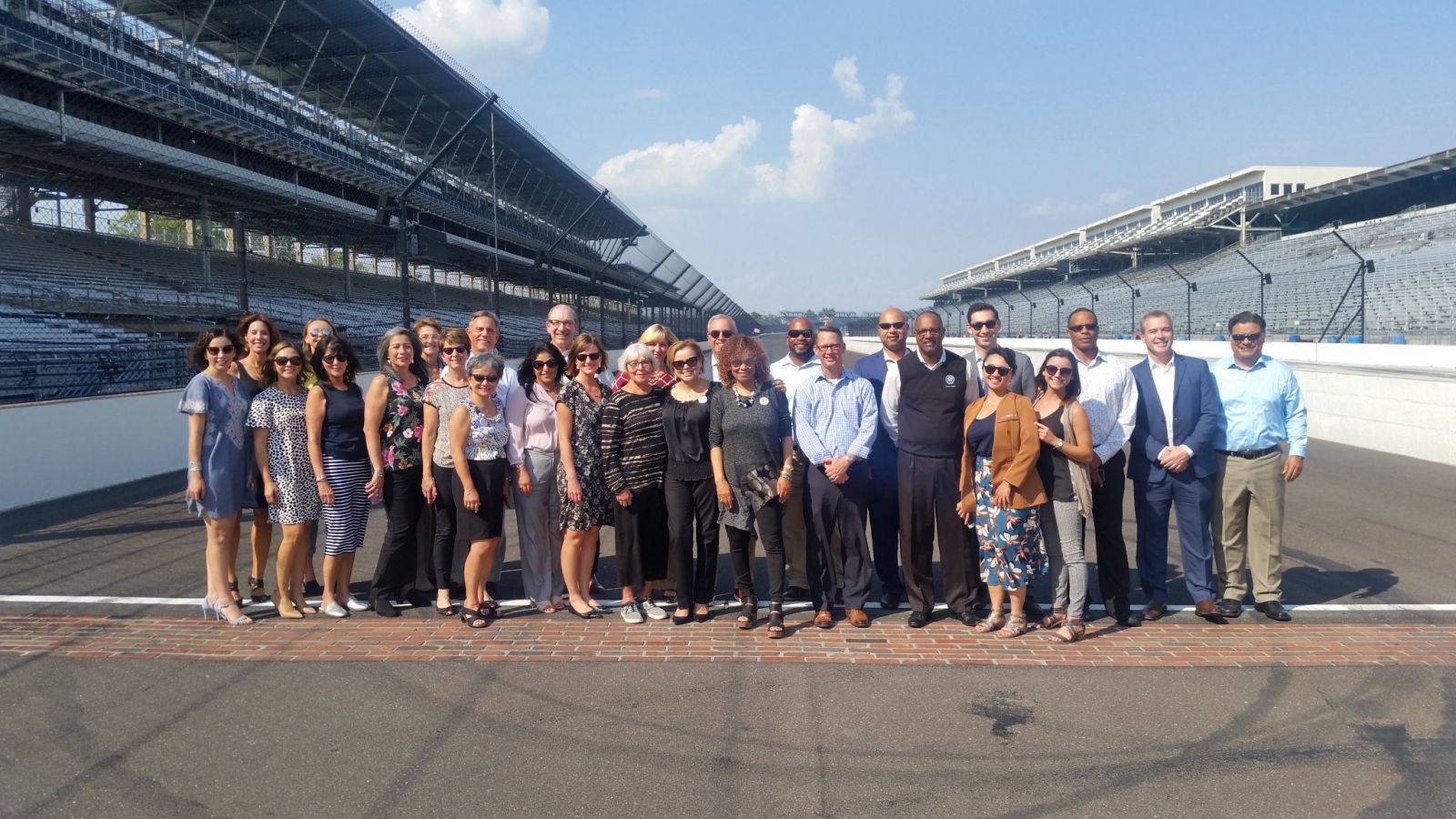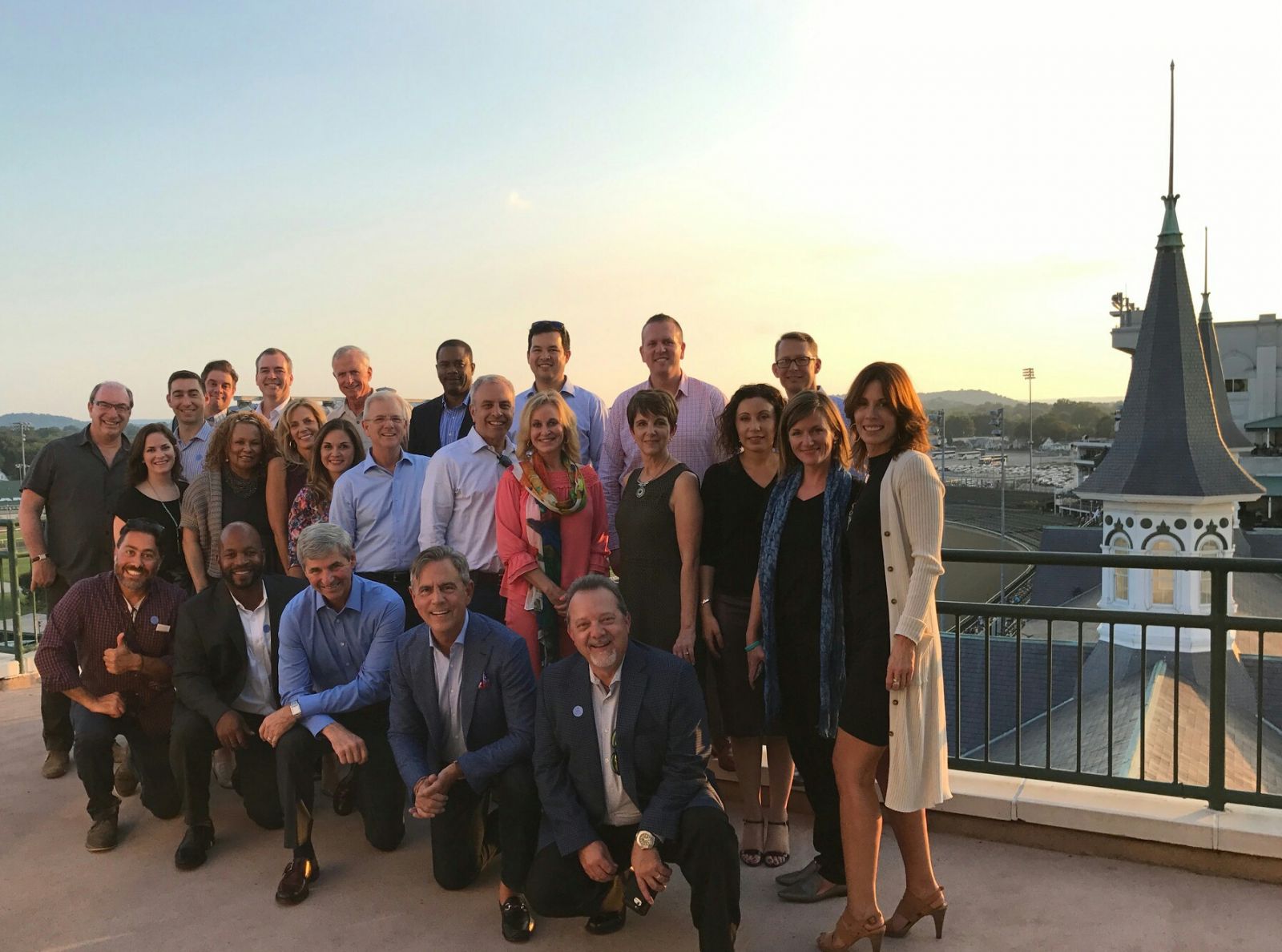Each year, EDC carefully selects a peer metro for our annual Best Practices Leadership Trip – a chance for EDC and a group of key partners and stakeholders to learn from another region facing challenges similar to our own. The decision to go to Indianapolis this year was not a hard one. We were drawn to Indy not just as a fellow participant in the Brookings Inclusive Economic Development Learning Lab last year, but because of its regional approach to inclusive growth that has catalyzed since. We were further intrigued by Indy’s unique talent attraction and retention programs and its many collaborative efforts across government, business, and philanthropy. Over three days, our group of nearly 30 San Diegans was welcomed by Indy’s civic leaders who highlighted local programs, projects, and initiatives. Ultimately, our goal of the Leadership Trip is to inspire fresh approaches to our own challenges and opportunities at home.
A two-sided economy: The Indy Chamber kicked-off our visit with an overview of the economic disparities facing Indianapolis. Similar to EDC, the Indy Chamber led its region through the Brookings Institution Inclusive Growth Learning Lab designed to help economic development organizations (EDOs) build a data-driven platform that articulates the economic case (and imperative) for inclusion. Since the lab, the Indy Chamber has disseminated the Indy narrative throughout town, with many civic leaders referencing its findings throughout our visit. While Indianapolis bodes well on measures affordability, job growth, and entrepreneurship, it is also the 6th most economically segregated region in the U.S., with limited opportunities for upward mobility for individuals born into poverty. The impacts of automation exacerbate economic segregation and poverty in Indianapolis, which lost more than 20 percent of its manufacturing workforce over the last decade. In facing these realities, civic leaders have enacted new measures to increase job preparedness, homeownership, and overall economic security for Indianapolis residents.
The Cook Medical “unicorn”: In a particularly moving presentation, Pete Yonkman, president of Cook Medical, shared an incredible benefit that his company offers employees who wish to advance their educational goals. With more than 12,000 employees worldwide, Cook is a privately-held medical device manufacturer headquartered in Indiana with facilities in six countries, including K-Tube Technologies in Poway. Through a program called “My Cook Pathway,” Cook eliminated its high school diploma requirement for entry-level manufacturing positions in 2017. High-potential individuals without a high school degree are hired to work at Cook in the mornings before spending the afternoon studying for their GED. During the seven weeks it takes to earn their high school equivalency (HSE), Cook pays employees full-time wages and associated fees. Furthermore, Cook has partnered with the local Ivy Tech Community College to expand the program for employees interested in AA degrees or certificate programs, fronting registration fees and associated expenses and providing guidance on the financial aid process. After overwhelming response from its employees, Cook has since expanded the program even further. Now, Cook employees can get an HSE through a Master’s degree leveraging the My Cook Pathway program. Before introducing this program, fewer than 65 employees took advantage of education reimbursement. Two years later, more than 1,000 employees are enrolled. By leveraging various state and federal funding streams that support employee education, Cook offers this benefit to its employees for less than $2,000 per employee. When Cook leadership eliminated its high school diploma requirement, they decided they wouldn’t sit back and wait for highly educated employees to show up at their door. Now, they are active participants in preparing Indiana’s future workforce, with resumes flooding their doors and employee retention rates on the rise.
Connecting Talent: Through its lauded statewide community college system and multiple universities, Indianapolis is well positioned to produce the workforce its economy needs, but the Midwestern city risks losing talent to the “lure of the coasts.” Jason Kloth, CEO of Ascend Indiana, is front and center on a statewide effort to retain talent by increasing employer access to qualified workers while supporting the residents of Indiana in their pursuit of a meaningful career. After serving in many leadership positions for Teach for America, Kloth led the City of Indianapolis Office of Education Innovation (OEI) as the deputy mayor of education under Mayor Greg Ballard. Kloth is the mastermind behind Ascend, a nonprofit focused on creating a stronger alignment between the supply of skilled talent and demand from employers in Central Indiana. Ascend has raised more than $10 million to support its work. The organization provides strategic consulting services to help high-growth companies identify, evaluate, and secure education partners to deliver a custom talent pipeline, usually in less than a year. In a recent project with medical device giant Roche, Ascend partnered with the University of Indianapolis to address the company’s shortage of technicians fueled by increased retirement turnover. The result was a work-ready pipeline of 25 skilled, entry-level professionals in less than 12 months. Ascend has also created a next-level, cloud-based platform called “the Ascend Network” that matches qualified talent from 14 higher education institutions to positions at more than 70 large companies. The platform has helped place more than 400 individuals in Indiana. Through its experienced team of recruiters and matching algorithms, Ascend ensures high quality candidates and speeds up the hiring process for both individuals and companies. Needless to say, our group was astonished.
Before returning home, many members of our San Diego group continued onto Washington D.C. for a day at the Brookings Institution. The group was welcomed by Amy Liu, vice president and director of the Brookings Metropolitan Program, before Brookings fellows facilitated a series of discussions on how and why other metros are approaching inclusive growth to help us think more broadly about strategies for succeeding in a rapidly-changing economy.
San Diego’s Progress
After spending much of 2017 deepening our understanding of regional challenges facing San Diego, EDC has spent 2018 assembling an employer-led steering committee to build an inclusive growth agenda that benefits more people, companies and communities. Guided by the findings of a recent EDC study, EDC’s Inclusive Growth Steering Committee recently endorsed a regional goal to double the number of skilled workers produced in San Diego County to 20,000 per year by 2030. To support this goal, the committee developed recommendations around transparency, engagement, and investment for employers to adopt and implement within their own organizations. EDC continues to work with the steering committee to set goals and recommendations for employer engagement around our other two pillars of inclusive growth; small business competitiveness and addressing affordability.
Before Indy, we traveled to Nashville and Louisville, smaller regions confronting deeply entrenched histories of racial segregation and poverty. Indianapolis is home to one of the largest endowments in the country and would not be where it is today without the investment of the Lilly family. Each metro is unique in its history, resources, and politics, and will inevitably need to craft an inclusive economic development strategy that works for their community based on their particular circumstance. However, inclusive growth as both an economic and moral imperative is a sentiment that permeates among more and more leaders nationwide.
Regardless of how different our circumstance may be from Nashville, Louisville, or Indianapolis, the authenticity that is threaded throughout our visits each year encourages an honest dialogue among our San Diego delegation, leading to a heightened sense of unity in purpose and mission amongst our investors and newer partners. There is much to be done, but EDC and our stakeholders are committed to this work. It will remain driven by collaboration, coordination, and honesty. EDC’s mission is to maximize the region’s economic prosperity and global competitiveness. To live up to that mission, our economic development strategies must promote growth through inclusion.
Learn more at inclusiveSD.org.

The trip was made possible by the generous support of Southwest Airlines.
 Last week, members of the EDC team joined 20 board members, investors and partners on a trip to Louisville, Kentucky. The purpose was to learn about that city’s emphasis on inclusion and compassion as focal points for their branding and economic development efforts. We met passionate people—both in the private and public sectors—who are working hard to create a community that is uniquely Louisville.
Last week, members of the EDC team joined 20 board members, investors and partners on a trip to Louisville, Kentucky. The purpose was to learn about that city’s emphasis on inclusion and compassion as focal points for their branding and economic development efforts. We met passionate people—both in the private and public sectors—who are working hard to create a community that is uniquely Louisville.